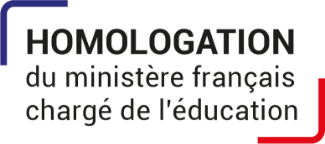Middle School
Our middle school years endow students with an experience that unlocks limitless opportunities.
Limitless Opportunities
San Diego French-American middle schoolers thrive in the bilingual, bicultural, and bi-literate setting that has been firmly grounded throughout the elementary years. Students who have attended the school from Pre-Elementary to 8th Grade flourish when transitioning to French lycées, to international schools preparing the International Baccalaureate (IB) Diploma Program, or to American high schools.
Leadership Skills
Beginning with 6th Grade, students are expected to behave more autonomously, and to develop their independent thinking skills, while learning to interact as part of a group. Through Cycle 4, 7th and 8th Grade students are encouraged to build leadership skills, and at the same time, to value the ethics of team spirit. The rigorous academic program supports the students in developing organizational and communication skills, in preparation for the challenges of high school study. Critical thinking and enquiry are essential components across the spectrum of the subjects studied, and in each language used. Students learn to be more self-confident in front of an audience by participating in in-class oral presentations, presenting topics or short performances, and being involved in public speaking.

Emotional Intelligence
As the middle school years can be challenging emotionally to adolescents who are learning to cope with the changes taking place within and around them, the school psychologist provides both individual and group support for students. The year begins with a short series of presentations that address issues such as self-respect, teamwork, conflict resolution, coping with bullying, and cyber-bullying etc. Students are encouraged to participate in discussion, and are provided with tools to use when encountering obstacles to personal relationships. Supporting the students emotionally is important for their academic and personal growth.

Art
Middle school students learn about the arts through Scholastic Art’s program, which provides high-interest themes related to an important artist or movement, classic and contemporary. Each topic studied is supported by an art activity that creates an artwork connected to the style of the featured artist or movement.

Physical Education and Sports League
San Diego French-American School further fosters independence and team spirit by sponsoring a middle school sports league team, competing in various events with small independent schools in the San Diego North County region. Each grade also participates in a week-long educational field trip that further encourages learning how to function as a team while learning to become more independent.
After 2 years of COVID-19 restrictions, San Diego French-American School is back competing in Fall 2023 Sports League competition! This season, we had over 60 students sign-up! Our teams competed against six other middle schools in Co-Ed Flag Football, Boys & Girls Cross-Country, and Girls Volleyball.
It was an impressive year with our Flag Football Team qualifying for the league championship game, and bringing home the 2nd place trophy! The Girls Cross-Country Team and Boys Cross-Country Team were BOTH crowned League Champions, and were awarded 1st place trophies! It was the first time in San Diego French-American School history that both cross-country teams swept the league!

Community Service
All middle school students are encouraged to develop an understanding of the society in which they live by participating in community service, either through school sponsored projects, such as visiting a local homeless shelter, contributing to an annual food drive, or by volunteering after school within their local community.
Committees and Student led Initiatives
All middle school students are encouraged to develop an understanding of how our school functions and are encourage to take place in the decision making of the school. Our student representatives are a key component of our class and school councils. The Middle School offers every student the opportunity to participate in various committees where they can make their voices heard. The Eco Committee aims to support green initiatives on campus while the Party Planning Committee organizes various events and activities for the Middle School students.
Evaluation
All middle school students are encouraged to develop an understanding of how our school functions and are encourage to take place in the decision making of the school. Our student representatives are a key component of our class and school councils. The Middle School offers every student the opportunity to participate in various committees where they can make their voices heard. The Eco Committee aims to support green initiatives on campus while the Party Planning Committee organizes various events and activities for the Middle School students.

Middle School Curriculum
At San Diego French-American School, our curriculum aims to nurture global citizens who have the tools to navigate our world. Each subjects is taught through the lens of these 5 domains. Our blended French/English curriculum weaves the Common Core Standards, the NGS standards and the French National Education’s standards in every lesson. The Middle School program aims to provide students with the necessary tools to transition smoothly to any High School of their choice
6th Grade:
The sixth grade language arts program, in both French and English, has a strong foundation in reading for word recognition, vocabulary and concepts, and reading comprehension. Reading comprehension may include reading informational materials: such as newspapers, magazines, online information, selected texts, and genres from classical and contemporary literature. Students begin to develop analytical and writing skills in responding to literature studied. There is a strong emphasis on grammar as a base for producing good writing.
Examples of novels studied are: Where the Red Fern Grows, by Wilson Rawls, Walk Two Moons, by Sharon Creech, Les metamorphoses d’Ovide, Le Chat Noir, by Edgar Allen Poe.
The program is complemented by studying the moving image, which could be a movie related to a text studied, or a film that supplements the text. In addition to writing responses to literature, students practice writing narrative, expository, persuasive, and descriptive essays, and research reports that may be connected to a theme studied in American Social Studies or the study of antiquity in French. In Spanish, the students reinforce basic vocabulary and begin to develop oral communication skills.
7th Grade:
The seventh grade language arts program, in both French and English, continues to build on reading for word recognition, vocabulary and concepts, and reading comprehension. Reading comprehension may include reading informational materials: such as newspapers, magazines, online information, selected texts and genres from classical and contemporary literature. Students continue to develop analytical and writing skills in responding to literature studied. Correct use of grammar as a base for producing good writing remains a key component. Examples of novels studied are: The Outsiders, by S. E. Hinton, Roll of Thunder Hear my Cry, by Mildred D. Taylor, Le temps des miracles by Anne-Laure Baudoux, Les fables de La Fontaine or Le Roman de Renart.
The program is complemented by studying the moving image, which could be a movie related to a text studied, or film that supplements the text. In addition to writing responses to different genres, students build on essay writing through organization and focus, research and use of technology, evaluation and revision. In Spanish, the students increase their understanding through vocabulary and conversation – using the present and the future tenses, discussing everyday life and activities.
8th Grade:
The eighth grade language arts program aims to provide students with the necessary tools to transition smoothly to ninth grade. Reading comprehension, in both French and English, includes reading informational materials: such as newspapers, magazines, online information, selected texts, and genres from classical and contemporary literature. Students progress further in acquisition of analytical and writing skills in responding, at greater length, to literature studied. Written work is expected to be clearly presented, using appropriate language and grammar, and the content to be well researched and documented.
Examples of literature studied are; A Midsummer Night’s Dream, by William Shakespeare, To Kill a Mockingbird, by Harper Lee; Antigone, by Jean Anouilh, and extracts from Maupassant, Gautier, and Villiers de L’Isle Adam. Expectations are that students will have a command of standard conventions in both the written and spoken language, in French and English, and have been exposed to a broad range of literature. In Spanish, 8th grade students will achieve a proficiency level that prepares them for admission into Spanish Level 1 or 2, in an American high school or its equivalent.
6th Grade:
In 6th grade students are introduced to the areas of study on which they will build depth and complexity throughout their middle school experience. The main areas of study are:
- Number Sense: Whole and decimal numbers; Operations: addition, subtraction, multiplication, division; Fractions: multiplying, dividing, converting, and equivalency; Proportions and unit rate; Integer and rational numbers; Number lines; Graphing: coordinate grids, naming points; Absolute value.
- Algebra – Expressions and Equations: Write and translate expressions and equations with variables; Apply properties and order of operations; Solve single variable equations.
- Statistics and probability: Summarize and analyze numerical data sets; Summarize and analyze categorical data sets; Analysis of averages, distribution and variability; Displays of data graphically.
- Measurement: Unit conversions; Average speed: rate of flow; Angles; Perimeter, area and volume of regular figures.
- Geometry: Use vocabulary and trace geometric objects; Parallel and perpendicular lines; Angles; Triangles and quadrilaterals; Study of complex geometric figure.
- Problem solving and multiple representations.
7th Grade:
In 7th Grade students continue to develop skills and competencies that are essential for mastering the areas of study introduced in 6th grade and essential for entering into high school mathematics. The areas of study are:
- Number Sense: Calculating with positive numbers and integers; Fractions: comparisons, equivalency, conversions, operations; Rational numbers; Arithmetic properties; Operations with rational, real numbers
- Algebra : Using algebraic terminology and symbology; Expressions and equations: Multiple representations – patterns, tables, graphs, and equation;, Simplifying and solving equalities and inequalities; Linear equations
- Measurement : Comparing and converting weights, geometric measures, times, and temperatures; Constructing and interpreting drawings made to scale; Perimeter, area, and volume of standard figures
- Geometry : Transformations: symmetries; Triangles: existence, properties; Parallelograms: properties, demonstrations; 3D geometry; Area and volume.
- Statistics and Probabilities : Relative frequency and data measure; Random sampling; Measurement precisions; Graphs and charts; Analysis of survey results; Probability: types of events and outcomes, diagrams of compound events and calculations
- Problem solving and multiple representations
- Coding : Algorithm and program, Event of an action, simple loops, conditional loops.
8th Grade:
In 8th grade students continue to add complexity to their skills and knowledge as they work to generalize and apply concepts across scenarios and areas of study. Algebra and geometry comprise a greater part of the curriculum. By the end of eighth grade students are well prepared to transition into high school mathematics in whichever sequence their chosen high school follows. The areas of study are:
- Number Sense: Integers; Fractions: calculations and problems; Exponents: standard notation, scientific notation, calculations; Radicals and absolute value; Rational and irrational numbers
- Algebra: Algebraic expressions: Distribution, factoring; Multi-step equations; Proportional relationships; Linear and nonlinear equations and inequalities; Systems of equations; Functions: define, evaluate, compare and use to model relationships
- Measurement : Quotients involving speed; Compound measurements
- Geometry : Pythagorean theorem; Geometry with proofs; Transformations; Congruence and similarity; Area and volume: cylinders, cones, spheres and balls; Intercept theorem
- Statistics and Probabilities Proportionality and graphic representation; Weighted average; Bivariate data: analysis and associations.
- Problem solving and multiple representations
- Coding Use of “for” loops; Use of “while” loops; Different types of variables; Assigning a variable.
6th Grade:
Since both the French and American curricula focus on ancient civilizations in the 6th Grade year, the programs are harmonized to ensure that the topics are covered in a balanced way, with reinforcement of ideas and vocabulary in both languages when possible. Students begin to develop higher levels of critical thinking and analyze development of cultures and their interactions through time (politics, religion, economics, social, and geographic backgrounds). Topics include the archaeological studies of the early physical and cultural development of humankind from the Paleolithic area to the agricultural revolution; the foundation of Greece, its cities, citizenship and democracy; Chinese dynasties; early civilization in India. Students research and write reports, which may be presented orally in class.
7th Grade:
The focus of world history and geography is on medieval and early modern times. The French and American curricula continue to be harmonized to ensure that students study selections from each, and gain a balanced perspective. In the American program, students study the social, cultural, and technological changes that took place in Europe, Africa, and Asia between AD500-1789. Areas studied include the rise and fall of the Roman Empire; the geographic, political, economic, religious, and social structures of Chinese civilizations in the Middle Ages, and sub-Saharan civilizations in Medieval Africa. In history, the French program areas study include the beginning of Islam; Feudalism in Western Europe during the XI-XV centuries; cultural and intellectual upheavals during the XV to XVII centuries. The French geography program treats topics such as sustainable development and unequally developed societies. Students continue to develop research and report writing skills in both French and English.
8th Grade:
Following the historical foundations established over the previous two years, 8th graders are introduced to revolutionary issues that are political, social, economic, and industrial in nature. The concept of citizenship and civil rights is explored in both languages in civic education. In geography, instruction in French covers concepts of urbanization and population mobility before addressing major themes of globalization and its environmental impact. Students are now developing a critical understanding of the world by working with various sources, verifying their reliability, and presenting their conclusions through group or individual projects.
6th Grade:
The program links the French Life and Earth Science with the American Earth Science curriculum. Where possible, students are presented with hands-on experiments and field trip experiences to supplement and enhance the curricula. Areas of study include:
- Characteristics of the immediate environment and distribution of living beings
- The origin of living matter: diversity, unity, and kinship of living beings
- Populating a space – the notion of species.
7th Grade:
The program links the French Life and Earth Science with the American 7th Grade Life Science curriculum. Where possible students are presented with hands-on experiments and field trip experiences to supplement and enhance the curricula. Students also begin to study Physics and Chemistry. Areas of study include:
- Respiration and functional occupation of living beings (Life and Earth Science)
- How an organ functions, and need for energy (Life and Earth Science)
- External geology: evolution of landscapes (Life and Earth Science)
- Water in the environment.(Physics-Chemistry)
- Electrical circuits with direct currents (Physics-Chemistry)
- Light (Physics-Chemistry)
8th Grade:
The eighth grade science curriculum synthesizes the physics content of the French and American programs. Areas covered include: composition of air; molecular model – gas, solid, liquid etc.; combustion; atoms, molecules; periodic table. Chemistry, earth, and life science are a part of the French curriculum and students study acids, bases, and solutions; electricity: resistance, voltage and intensity laws; light: optics – colors and images, light passing through a lens; the speed of light.
We have been very happy with San Diego French-American School and for the fabulous teaching staff, who not only maintain very high academic standards, but who also continuously instill a genuine love for learning in students of all ability levels.
Azita, mother of Vincent